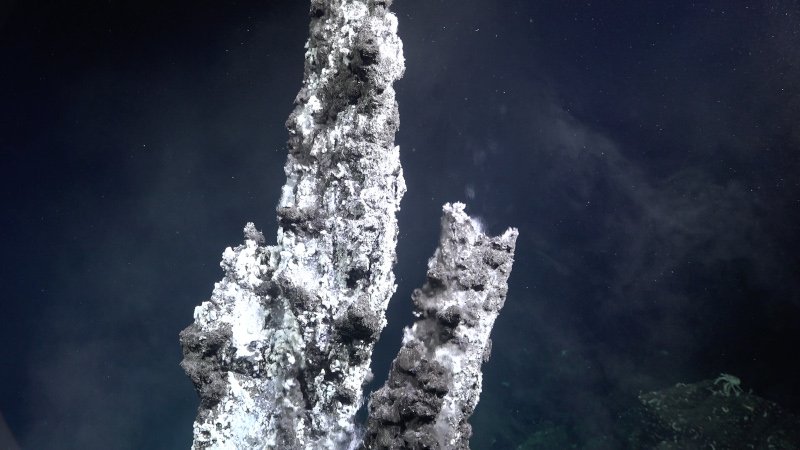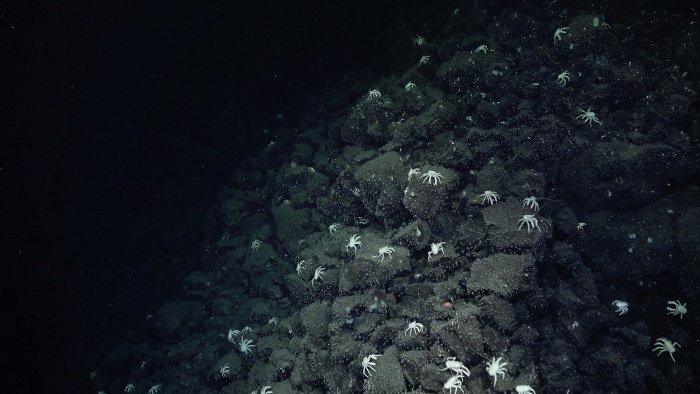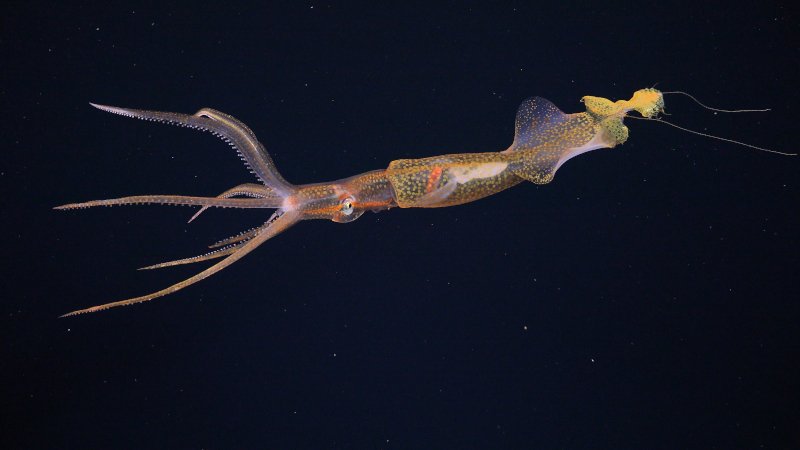Scientists on a Schmidt Ocean Institute expedition have discovered a new hydrothermal vent field larger than a professional soccer field. The vent field found in the Pacific Ocean off the Western Galápagos Islands consists of five geyser-like chimneys and three hot springs, like those you might see in Yellowstone. The hottest water temperature recorded was 288 degrees celsius (550 degrees fahrenheit).

The American and Ecuadorian research team on R/V Falkor (too), led by Dr. Roxanne Beinart of the University of Rhode Island and Dr. Jill McDermott from Lehigh University, detected chemical signatures of the 9,178 square meter vent field while surveying the region with Schmidt Ocean Institute’s underwater robot, ROV SuBastian. They found the vents and explored the area for over 43 hours, the longest dive for the robot in its 7 years of operation. The goal of the expedition was to characterize hydrothermal vents on the western side of the Galápagos spreading center and search for new vent fields.
The scientists found the vent field when a Galatheid crab, also known as a squat lobster, came into view. The number of crabs grew until the scientists finally arrived on the vent field and were excited to find giant tube worms nestled around the hot water. The Ecuadorian observers onboard the vessel, Ricardo Visaira Coronel of the Galápagos National Park and Dennisse Maldonado of INOCAR, named the vent field “Sendero del Cangrejo,” which translates to “Trail of the Crabs.”

The 30-day expedition began on 13 August 2023 on Schmidt Ocean Institute’s research vessel Falkor (too) in collaboration with the Galápagos National Park Directorate (GNPD), Charles Darwin Foundation, and the Ecuadorian Navy’s Oceanographic and Antarctic Institute (INOCAR). Other participating institutions included University of Rhode Island, Lehigh University, the Lamont-Doherty Earth Observatory, United States Geological Survey, Harvard University, and the University of Wisconsin, Madison.
“Scientists have known since the early 2000s that this vent field was likely there. But it was particularly hard to locate because the fluids are clear and do not emit large clouds into the water like black smokers do,” said Beinart. “It took our team of chemists, geologists, biologists, and a few crabs to find it.”
Hydrothermal vents were first discovered east of the Galápagos Islands in 1977. The international team on the current expedition were examining under-explored hydrothermal vents west of the islands and comparing them to the ones originally discovered.
“We are the first interdisciplinary team that has had the opportunity to thoroughly sample this area,” said McDermott. “It has been a privilege to contribute to the knowledge on Galápagos vents. Our goal with this work is to expand our understanding of how hydrothermal vents benefit and affect our entire planet through their chemistry, geology, and biology.”
The samples from the expedition will aid scientists in creating a more complete picture on how the vents west of the Galápagos may or may not be connected to the vents east of the islands. Some of the collected specimens may be new species due to the novelty of the site. Many hydrothermal vent fields have unique characteristics and by comparing the similarities and differences between vent fields, scientists will gain an understanding of how they are connected.

“Understanding and adding a better description of the distribution and unique nature of such deep-water hydrothermal communities is hugely important for the integral management of our oceans,” said Stuart Banks, Senior Marine Scientist at the Charles Darwin Foundation. “Such a discovery for the Galápagos and Eastern Tropical Pacific takes us important steps closer to ensuring hidden deep-water biodiversity is recognized, appreciated and built into ongoing conservation efforts.”
“This is the fourth hydrothermal vent field discovery made by scientists on our new research vessel Falkor (too) since March, in addition to the discovery in August of a new animal ecosystem living under hydrothermal vents,” said Schmidt Ocean Institute Executive Director Dr. Jyotika Virmani. “With 75% of the seafloor still to map, finding this new vent field shows how much we still have to learn about our planet and those who live on it. I am continually amazed by the otherworldly beauty of our seafloor and look forward to uncovering more.”
"The results of this expedition highlight the importance of interdisciplinary research and collaboration between different government and private organizations in the search for still unexplored ecosystems. This collaborative approach combines knowledge, resources, and technology to expand our understanding of nature and address the most complex environmental and scientific challenges of our time," said Danny Rueda, director of the Galápagos National Park Directorate.
For media, please contact:
Charles Darwin Foundation
Leslie León, Communications Officer
leslie.leon@fcdarwin.org.ec | +593 96 978 7679
Galapagos National Park Directorate
Rosa León, Information officer
rleon@galapagos.gob.ec | +593 96 985 4231
Schmidt Ocean Institute
Carlie Wiener, Comunicaciones
cwiener@schmidtocean.org | +1 808 628 8666
About the Organizations
Schmidt Ocean Institute was established in 2009 by Eric and Wendy Schmidt to catalyze the discoveries needed to understand our ocean, sustain life, and ensure the health of our planet through the pursuit of impactful scientific research and intelligent observation, technological advancement, open sharing of information, and public engagement, all at the highest levels of international excellence. For more information, visit www.schmidtocean.org.
Since 1959, the Charles Darwin Foundation has worked in close partnership with the Galápagos National Park Directorate to protect the Islands’ natural resources and share scientific results for the conservation of this living laboratory. More than one hundred scientists, educators, researchers, support personnel and volunteers from all over the world have participated in this effort. Currently, more than 75% of the staff are Ecuadorian citizens. The Charles Darwin Foundation is committed to the professional development of permanent Galápagos residents as future scientists, for the well-being of the islands and the nation in general. For more information visit: www.darwinfoundation.org
The Galapagos National Park Directorate is responsible for conserving the ecological health and biodiversity of the insular and marine ecosystems of the protected areas. They also ensure the rational use of goods and services that the protected areas generate for the community.
Ecuadorian Navy’s Oceanographic and Antarctic Institute (INOCAR) is a technical body of the National Maritime Authority of Ecuador and serves as the National Hydrographic Service. It performs several functions related to hydrography and marine navigation, including hydrographic surveying, chart production, maintenance of aids to navigation, oceanic condition monitoring, provision of weather forecasts, and issuance of tsunami alerts. INOCAR also plays a pivotal role in controlling and monitoring oceanographic exploration and research activities to ensure their effective execution and alignment with national regulations. For more information visit: www.inocar.mil.ec
As one of the nation’s premier academic institutions of oceanography and ocean exploration, the University of Rhode Island’s Graduate School of Oceanography educates marine scientists, students, policymakers, business leaders and citizens and helps develop the knowledge and skills necessary to address present and future marine challenges. Through field and ship-based observations, laboratory work and modeling, its faculty and researchers provide a comprehensive approach to studying the coastal and blue water ocean throughout the world.
Lehigh is one of the nation’s most distinguished private research universities. Through academic rigor, an entrepreneurial mindset and collaborative opportunities we challenge our students to become the leaders of the future. Visit https://www1.lehigh.edu/home to learn more.
The University of Wisconsin-Madison, was founded in 1848 and is the flagship campus of the University of Wisconsin system. UW-Madison is a world-class center for Microbiology and the Life Sciences. Faculty at UW-Madison have been awarded the Nobel Prize, MacArthur award, National Medal of Sciences and elected to the National Academy of Science and Engineering. One of the longest and deepest traditions surrounding the University of Wisconsin, the Wisconsin Idea signifies a general principle: that education should influence people’s lives beyond the boundaries of the classroom. For more information visit: https://www.wisc.edu/about/.





